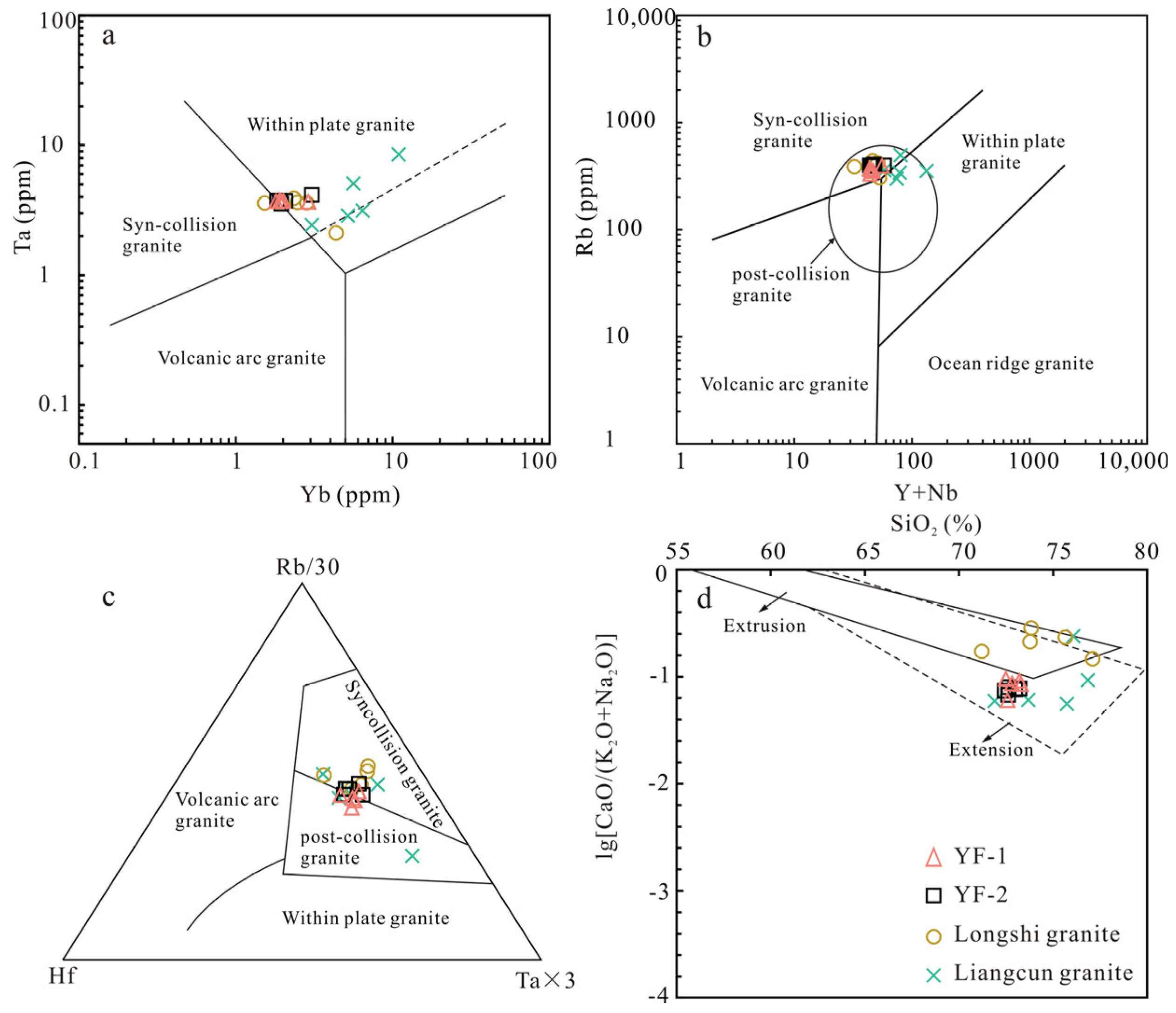U-Pb Geochronology, Geochemistry and Geological Significance of the Yongfeng Composite Granitic Pluton in Southern Jiangxi Province
Abstract
:1. Introduction
2. Geological Setting and Petrography
3. Sample Information and Analysis Methods
3.1. Zircon U-Pb Dating and Trace Elements
3.2. Major and Trace Element Analysis
3.3. Electron Probe Microanalysis (EPMA)
4. Results
4.1. Zircon Trace Element Geochemistry
4.2. Zircon U-Pb Age
4.3. Element Geochemistry of Granite
4.4. Element Geochemistry of Biotite
5. Discussion
5.1. Rock-Forming Age
5.2. Rock-Forming Physicochemical Conditions
5.2.1. Temperature
5.2.2. Oxygen Fugacity
5.3. Genetic Type
5.4. Petrogenesis
5.5. Tectonic Implication
5.6. Relationship between Magmatism and Mineralization
6. Conclusions
- (1)
- The Yongfeng composite granitic pluton is rich in silicon, potassium, and alkali, weakly peraluminous, poor in calcium and iron, and has a high content of ∑REE, with the enrichment of LREEs and significant fractionation of LREEs and HREEs. It is also enriched in LILEs such as Rb, Th, U, and Pb, and strongly depleted in elements such as Ba, K, P, Eu, and Ti, showing a clear negative Eu anomaly.
- (2)
- The Yongfeng composite granitic pluton does not contain alkaline dark minerals, and has low contents of TFe2O3, MgO, CaO, TiO2, and P2O5, which decrease with increasing SiO2 content. The negative Eu anomaly is significant and the Rb/Sr ratio is high. This evidence indicates the crystallization differentiation of minerals such as plagioclase, potassium feldspar, biotite, zircon, monazite, and ilmenite/rutile during magma evolution. The average zircon saturation temperature is 776 °C, the average TFe2O3/MgO ratio is 4.81, and the average Zr + Nb + Ce + Y content is 280.6 ppm, indicating that it is a highly fractionated I-type granite.
- (3)
- The crystallization age of the Yongfeng granite and the Longshi granite are 152.0 ± 1.0 Ma–151.3 ± 1.1 Ma and 148.9 ± 1.2 Ma, respectively. They are products of large-scale magmatic activity in the Nanling region during the Late Jurassic. Further, they formed in the extensional tectonic setting during the post-orogenic stage, under the control of the breakup or retreat of the backplate after the subduction of the Pacific Plate into the Nanling hinterland.
- (4)
- The magmatic system of the Yongfeng composite granitic pluton is characterized by high fractionation, high F content, high temperature, and low oxygen fugacity, which is conducive to the large-scale mineralization of Sn, Mo, and fluorite.
Supplementary Materials
Author Contributions
Funding
Data Availability Statement
Conflicts of Interest
References
- Wu, F.Y.; Guo, C.L.; Hu, F.Y.; Liu, X.C.; Zhao, J.X.; Li, X.F.; Qin, K.Z. Petrogenesis of the highly fractionated granites and their mineralizations in Nanling Range, South China. Acta Petrol. Sin. 2023, 39, 1–36, (In Chinese with English Abstract). [Google Scholar] [CrossRef]
- Webster, J.D. Exsolution of magmatic volatile phases from Cl-enriched mineralizing granitic magmas and implications for ore metal transport. Geochim. Cosmochim. Acta 1997, 61, 1017–1029. [Google Scholar] [CrossRef]
- Jahn, B.M.; Wu, F.Y.; Capdevila, R.; Martineau, F.; Zhao, Z.H.; Wang, Y.X. Highly evolved juvenile granites with tetrad REE patterns: The Woduhe and Baerzhe granites from the Great Xing’an Mountains in NE China. Lithos 2001, 59, 171–198. [Google Scholar] [CrossRef]
- Wu, F.Y.; Sun, D.Y.; Jahn, B.M.; Wilde, S.A. A Jurassic garnet-bearing granitic pluton from NE China showing tetrad REE patterns. J. Asian Earth Sci. 2004, 23, 731–744. [Google Scholar] [CrossRef]
- Tong, R.F.; Wu, Y.R.; Xing, Q.M. Geological Report on Detailed Survey of Mo Deposte in Leigongzhang, Xingguo County, Jiangxi Province. The National Geological Archive Center. 2011. Available online: http://dc.ngac.org.cn/museumDetails?id=10.35080%2Fn01.c.114677 (accessed on 1 July 2011). (In Chinese with English Abstract).
- Zhuang, X.G.; Cai, H.J.; Feng, W.D. Verification Report on Resource Reserves in the Longping Fluorite Deposite in Xingguo County, Jiangxi Province. 2010. The National Geological Archive Center. Available online: http://dc.ngac.org.cn/museumDetails?id=10.35080%2Fn01.c.158108 (accessed on 28 June 2010). (In Chinese with English Abstract).
- Tong, R.F.; Yang, R.D. Molybdenum mineralization characteristics of Leigongzhang molybdenum deposit and prospecting targets, Jiangxi. Miner. Explor. 2012, 3, 755–760, (In Chinese with English Abstract). [Google Scholar]
- Yang, S.W.; Feng, C.Y.; Lou, F.S.; Zhang, F.R.; He, B.; Cao, Y.B. A preliminary study on metallogenic age and genesis of Longping fluorite deposit in Southern Jiangxi Province: Evidence from Sm-Nd isochron dating of fluorite and electron probe of biotite. Geol. J. China Univ. 2019, 25, 341–351, (In Chinese with English Abstract). [Google Scholar] [CrossRef]
- Yang, S.W.; Lou, F.S.; Zhang, F.R.; Wu, Z.C.; Feng, C.Y. Late Jurassic aluminum A-type granite belt in southern Jiangxi and its geological significance. Geol. Sci. Technol. Inf. 2019, 38, 12–29, (In Chinese with English Abstract). [Google Scholar] [CrossRef]
- Xu, Z.G.; Chen, Y.C.; Wang, D.H.; Chen, Z.H. Classification Scheme of China Metallogenic Zone; Geological Publishing House: Beijing, China, 2008; (In Chinese with English Abstract). [Google Scholar]
- Wang, D.Z.; Shu, L.S. Late Mesozoic basin and range tectonics and related magmatism in Southeast China. Geosci. Front. 2012, 3, 109–124. [Google Scholar] [CrossRef]
- Li, J.W.; Zhou, M.F.; Li, X.F.; Fu, Z.R.; Li, Z.J. The Hunan-Jiangxi strike-slip fault system in southern China: Southern termination of the Tan-Lu fault. J. Geodyn. 2001, 32, 333–354. [Google Scholar] [CrossRef]
- Wang, D.H.; Wang, Y.; Qin, J.H. Geology of Mineral Resources in China·Volume of Nanlling; Geological Publishing House: Beijing, China, 2022; pp. 82–84, (In Chinese with English Abstract). [Google Scholar]
- Wang, Y.; Wang, D.H.; Qin, J.H. Geology of Mineral Resources in China·Metallogenic Regularity Map of the Nanling Metallogeny Belt (1:800000); Geological Publishing House: Beijing, China, 2022; (In Chinese with English Abstract). [Google Scholar]
- Zhao, Z.; Wang, D.H.; Bagas, L.; Chen, Z.Y. Geochemical and REE mineralogical characteristics of the Zhaibei Granite in Jiangxi Province, southern China, and a model for the genesis of ion-adsorption REE deposits. Ore Geol. Rev. 2022, 140, 104579. [Google Scholar] [CrossRef]
- Andersen, T. Correction of common lead in U-Pb analyses that do not report 204Pb. Chem. Geol. 2002, 192, 59–79. [Google Scholar] [CrossRef]
- Hou, K.J.; Li, Y.H.; Tian, R.Y. In situ U-Pb zircon dating using laser ablation-multi ion counting-ICP-MS. Miner. Depos. 2009, 28, 481–492, (In Chinese with English Abstract). [Google Scholar] [CrossRef]
- Lin, W.W.; Peng, L.J. The estimation of Fe3+ and Fe2+ contents in amphibole and biotite from EMPA data. J. Chang. Univ. Earth Sci. 1994, 24, 155–162, (In Chinese with English Abstract). [Google Scholar]
- Hoskin, P.W.O. Trace-element composition of hydrothermal zircon and the alteration of Hadean zircon from the Jack Hills, Australia. Geochim. Cosmochim. Acta 2005, 69, 637–648. [Google Scholar] [CrossRef]
- Sun, S.S.; McDonough, W.F. Chemical and isotopic systematics of oceanic basalts: Implications or mantle composition and processes. Geol. Soc. Lond. Spec. Publ. 1989, 42, 313–345. [Google Scholar] [CrossRef]
- Rubatto, D.; Gebauer, D. Use of cathodoluminescence for U-Pb zircon dating by IOM Microprobe: Some examples from the western Alps. In Cathodoluminescence in Geoscience; Pagel, M., Barbin, V., Blanc, P., Ohnenstetter, D., Eds.; Springer: Berlin/Heidelberg, Germany, 2000; pp. 373–400. [Google Scholar]
- Wu, Y.B.; Zheng, Y.F. Genesis of zircon and its constraints on interpretation of U-Pb age. Chin. Sci. Bull. 2004, 49, 1554–1569, (In Chinese with English Abstract). [Google Scholar] [CrossRef]
- Wang, L.L. Geochemistry and Petrogenesis of Early Paleozoic-Mesozoic Granites in Ganzhou, Jiangxi Province, South China Block. Ph.D. Thesis, China University of Geosciences (Beijing), Beijing, China, 2015. (In Chinese with English Abstract). [Google Scholar]
- Li, X.H.; Li, Z.X.; Li, W.X.; Liu, Y.; Yuan, C.; Wei, G.J.; Qi, C.S. U-Pb zircon, geochemical and Sr-Nd-Hf isotopic constraints on age and origin of Jurassic I- and A-type granites from central Guangdong, SE China: A major igneous event in response to foundering of a subducted flat-slab? Lithos 2007, 96, 186–204. [Google Scholar] [CrossRef]
- Qiu, J.S.; Xiao, E.; Hu, J.; Xu, X.S.; Jiang, S.Y.; Li, Z. Petrogenesis of highly fractionated I-type granites in the coastal area of northeastern Fujian Province: Constraints from zircon U-Pb geochronology, geochemistry and Nd-Hf isotopes. Acta Petrol. Sin. 2008, 24, 2468–2484, (In Chinese with English Abstract). [Google Scholar]
- Nachit, H.; Ibhi, A.; Abia, E.H.; Ben Ohoud, M. Discrimination between primary magmatic biotites, equilibrated biotites and neoformed biotites. Comptes Rendus Geosci. 2005, 337, 1415–1420. [Google Scholar] [CrossRef]
- Foster, M.D. Interpretation of the Composition of Trioctahedral Micas; United States Geological Survey Professional Paper 354B; United States Geological Survey: Reston, VA, USA, 1960; pp. 11–49. [Google Scholar]
- Liu, B.X.; Li, Y.M. Chief progress in 1:50000 regional geological survey during the 9th five-year-plan in Jiangxi. Jiangxi Geol. 2001, 15, 225–229, (In Chinese with English Abstract). [Google Scholar]
- Qiu, Y.L. Description of 1/50000 Geologic Map of Xingguo County Sheet (G-50-63-B). The National Geological Archive Center. 1989. Available online: http://dc.ngac.org.cn/museumDetails?id=10.35080%2Fn01.c.77463 (accessed on 22 April 2021). (In Chinese with English Abstract).
- Cui, Y.Y. Geochronology, Geochemistry and Petrogenesis of the Granitoids in the Sanming-Ganzhou Area, South China. Master’s Thesis, China University of Geosciences (Beijing), Beijing, China, 2014. (In Chinese with English Abstract). [Google Scholar]
- Feng, C.Y.; Zeng, Z.L.; Qu, W.J.; Liu, J.S.; Li, H.P. A geochronological study of granite and related mineralization of the Zhangjiadi molybdenite-tungsten deposit in Xingguo County, southern Jiangxi Province, China, and its geological significance. Acta Petrol. Sin. 2015, 31, 709–724, (In Chinese with English Abstract). [Google Scholar]
- Shu, X.J.; Chen, Z.H.; Zhu, Y.H.; Liao, S.B.; Zhou, B.W.; Li, G.Z.; Zhao, X.C.; Liu, S.; Chen, L.C. Genesis of Donggu highly fractionated granites, Xingguo, southern Jiangxi, and its geological significance. Geol. Rev. 2018, 64, 108–126, (In Chinese with English Abstract). [Google Scholar] [CrossRef]
- Wang, W.P.; Chen, Y.C.; Wang, D.H.; Chen, Z.Y. Zircon LA-ICP-MS U-Pb dating and petrogeochemistry of the Liangcun granites and their petrogenesis, south Jiangxi. Geotecton. Metallog. 2014, 38, 347–358, (In Chinese with English Abstract). [Google Scholar]
- Yu, Y.; Chen, Z.Y.; Chen, Z.H.; Hou, K.J.; Zhao, Z.; Xu, J.X.; Zhang, J.J.; Zeng, Z.L. Zircon U-Pb dating and mineralization prospective of the Triassic Qingxi pluton in southern Jiangxi Province. Geotecton. Metallog. 2012, 36, 413–421, (In Chinese with English Abstract). [Google Scholar] [CrossRef]
- Yang, S.W.; Lou, F.S.; Zhang, F.R.; Zhou, C.H.; Xia, M.; Ling, L.H.; Feng, Z.H. Detrital zircon U-Pb geochronology of the Xunwu Formation in Cathaysia Block and its geological significance. J. East China Univ. Technol. (Nat. Sci.) 2022, 45, 207–222, (In Chinese with English Abstract). [Google Scholar]
- Shen, W.Z.; Zhu, J.C.; Liu, C.S.; Xu, S.J.; Lin, H.F. Sm-Nd isotopic study of basement metamorphic rocks in South China and its constraint on material sources of granitoids. Acta Petrol. Sin. 1993, 9, 115–124, (In Chinese with English Abstract). [Google Scholar]
- Ferry, J.M.; Watson, E.B. New thermodynamic models and revised calibrations for the Ti-in-zircon and Zr-in-rutile thermometers. Contrib. Mineral. Petrol. 2007, 154, 429–437. [Google Scholar] [CrossRef]
- Miller, C.F.; McDowell, S.M.; Mapes, R.W. Hot and cold granites? Implications of zircon saturation temperatures and preservation of inheritance. Geology 2003, 31, 529–532. [Google Scholar] [CrossRef]
- Watson, E.B.; Harrison, T.M. Zircon thermometer reveals minimum melting conditions on earliest earth. Science 2005, 308, 841–844. [Google Scholar] [CrossRef]
- Watson, E.B.; Harrison, T.M. Zircon saturation revisited: Temperature and composition effects in a variety of crustal magma types. Earth Planet Sci. Lett. 1983, 64, 295–304. [Google Scholar] [CrossRef]
- Trail, D.; Watson, E.B.; Tailby, N.D. The oxidation state of Hadean magmas and implications for early Earth’s atmosphere. Nature 2011, 480, 79–82. [Google Scholar] [CrossRef]
- Li, W.K.; Cheng, Y.Q.; Yang, Z.M. Geo-fO2: Integrated software for analysis of magmatic oxygen fugacity. Geochem. Geophys. Geosystems 2019, 20, 2542–2555. [Google Scholar] [CrossRef]
- Ballard, J.R.; Palin, M.J.; Campbell, I.H. Relative oxidation states of magmas inferred from Ce(IV)/Ce(III) in zircon: Application to porphyry copper deposits of northern Chile. Contrib. Mineral. Petrol. 2002, 144, 347–364. [Google Scholar] [CrossRef]
- Liang, H.Y.; Campbell, I.H.; Allen, C.; Sun, W.D.; Liu, C.Q.; Yu, H.X.; Xie, Y.W.; Zhang, Y.Q. Zircon Ce4+/Ce3+ ratios and ages for Yulong ore-bearing porphyries in eastern Tibet. Miner. Depos. 2006, 41, 152–159. [Google Scholar] [CrossRef]
- Sun, Z.L. Geochronology and oxygen fugacity of Mesozoic granites in Nanling area of South China. J. Earth Sci. Environ. 2014, 36, 141–151, (In Chinese with English Abstract). [Google Scholar]
- David, R.W.; Hans, P.E. Stability of biotite: Experiment, theory, and application. Am. Mineral. 1965, 50, 228–1272. [Google Scholar]
- Wu, F.Y.; Li, X.H.; Yang, J.H.; Zheng, Y.F. Discussions on the petrogenesis of granites. Acta Petrol. Sin. 2007, 23, 1217–1238, (In Chinese with English Abstract). [Google Scholar]
- Chappell, B.W. Aluminium saturation in I- and S-type granites and the characterization of fractionated haplogranites. Lithos 1999, 46, 535–551. [Google Scholar] [CrossRef]
- Dan, W.; Li, X.H.; Wang, Q.; Wang, X.C.; Liu, Y.; Wyman, D.A. Paleoproterozoic S-type granites in the Helanshan Complex, Khondalite Belt, North China Craton: Implications for rapid sediment recycling during slab break-off. Precambrian Res. 2014, 254, 59–72. [Google Scholar] [CrossRef]
- Kemp, A.I.S.; Hawkesworth, C.J.; Foster, G.L.; Paterson, B.A.; Woodhead, J.D.; Hergt, J.M.; Gray, C.M.; Whitehouse, M.J. Magmatic and crustal differentiation history of granitic rocks from Hf-O isotopes in zircon. Science 2007, 315, 980–983. [Google Scholar] [CrossRef]
- Wolf, M.B.; London, D. Apatite dissolution into peraluminous haplogranitic melts: An experimental study of solubilities and mechanisms. Geochim. Cosmochim. Acta 1994, 58, 4127–4245. [Google Scholar] [CrossRef]
- Whalen, J.B.; Currie, K.L.; Chappell, B.W. A-type granites: Geochemical characteristics, discrimination and petrogenesis. Contrib. Mineral. Petrol. 1987, 95, 407–419. [Google Scholar] [CrossRef]
- Zhou, Z.M.; Ma, C.Q.; Wang, L.X.; Chen, S.G.; Xie, C.F.; Li, Y.; Liu, W. A source-depleted Early Jurassic granitic pluton from South China: Implication to the Mesozoic juvenile accretion of the South China crust. Lithos 2018, 300–301, 278–290. [Google Scholar] [CrossRef]
- Chappell, B.W.; White, A.J.R. I- and S-type granites in the Lachlan Fold Belt. Trans. R. Soc. Edinb. Earth Sci. 1992, 83, 1–26. [Google Scholar] [CrossRef]
- King, P.L.; White, A.J.R.; Chappell, B.W.; Allen, C.M. Characterization and origin of aluminous A-type granites from the Lachlan Fold Belt, Southeastern Australia. J. Petrol. 1997, 38, 371–391. [Google Scholar] [CrossRef]
- Clemens, J.D. S-type granitic magmas-pertogenetic issues, model and evidence. Earth-Sci. Rev. 2003, 61, 1–18. [Google Scholar] [CrossRef]
- Griffin, W.L.; Wang, X.; Jackson, S.E.; Pearson, N.J.; O’Reilly, S.Y.; Xu, X.S.; Zhou, X.M. Zircon chemistry and magma genesis, SE China: In-situ analysis of Hf isotopes, Tonglu and Pingtan Igneous complexes. Lithos 2002, 61, 237–269. [Google Scholar] [CrossRef]
- Tao, J.; Li, W.; Li, X.; Cen, T. Petrogenesis of early Yanshanian highly evolved granites in the Longyuanba area, southern Jiangxi Province: Evidence from zircon U-Pb dating, Hf-O isotope and whole-rock geochemistry. Sci. Sin. Terrae 2013, 43, 760–778, (In Chinese with English Abstract). [Google Scholar] [CrossRef]
- Chen, P.R.; Zhou, X.M.; Zhang, W.L.; Li, H.M.; Fan, C.F.; Sun, T.; Chen, W.F.; Zhang, M. Genesis and significance of the Early Yanshanian syenite-granite complex in the eastern section of Nanling. Sci. China (Ser. D) 2004, 48, 912–924, (In Chinese with English Abstract). [Google Scholar] [CrossRef]
- Guo, X.S.; Chen, J.F.; Zhang, X.; Tang, J.F.; Xie, Z.; Zhou, T.X.; Liu, Y.L. Nd isotopic ratios of K-enriched magmatic complexes from southeastern Guangxi Province: Implications for upwelling of the mantle in southeastern China during the Mesozoic. Acta Petrol. Sin. 2001, 17, 19–27, (In Chinese with English Abstract). [Google Scholar]
- Liu, C.S.; Chen, X.M.; Wang, R.C.; Hu, H. Origin of Nankunshan aluminous A-type granite, Longkou County, Guangdong Province. Acta Petrol. Mineral. 2003, 22, 1–10, (In Chinese with English Abstract). [Google Scholar] [CrossRef]
- Liu, Y.S.; Hu, Z.S.; Zong, K.Q.; Gao, C.G.; Gao, S.; Xu, J.; Chen, H.H. Reappraisement and refinement of zircon U-Pb isotope and trace element analyses by LA-ICP-MS. Chin. Sci. Bull. 2010, 55, 1535–1546. [Google Scholar] [CrossRef]
- Xu, X.S.; Lu, W.M.; He, Z.Y. The age and genesis of Fogang granitic batholith and Wushi diorite-hornblende gabbro. Sci. China (D) 2007, 37, 27–38, (In Chinese with English Abstract). [Google Scholar] [CrossRef]
- Li, X.H.; Li, W.X.; Wang, X.C.; Li, Q.L.; Liu, Y.; Tang, G.Q. Role of mantle-derived magma in genesis of Early Yanshanian granites in the Nanling Range, South China: In situ zircon Hf-O isotopic constraints. Sci. China (Ser. D) 2009, 52, 1262–1278, (In Chinese with English Abstract). [Google Scholar] [CrossRef]
- Zhao, K.D.; Jiang, S.Y.; Zhu, J.C.; Li, L.; Dai, B.Z.; Jiang, Y.H.; Ling, H.F. Hf isotopic composition of zircons from the Huashan-Guposhan intrusive complex and their mafic enclaves in northeastern Guangxi: Implication for petrogenesis. Chin. Sci. Bull. 2009, 54, 3716–3725, (In Chinese with English Abstract). [Google Scholar] [CrossRef]
- Taylor, S.R.; McLennan, S.M. The Continental Crust: Its Composition and Evolution; Blackwell Scientific Publisher: Hoboken, NJ, USA, 1985. [Google Scholar]
- Altherr, R.; Holl, A.; Hegner, E.; Langer, C.; Kreuzer, H. High-potassium, calc-alkaline I-type plutonism in the European Variscides: Northern Vosges (France) and northern Schwarzwald (Germany). Lithos 2000, 50, 51–73. [Google Scholar] [CrossRef]
- Patino-Douce, A.E.; Harris, N. Experimental constraints on Himalayan anatexis. J. Petrol. 1998, 39, 689–710. [Google Scholar] [CrossRef]
- Patino-Douce, A.E. What do Experiments Tell Us about the Relative Contributions of Crust and Mantle to the Origin of Granitic Magmas; Castro, A., Fernandez, C., Vigneresse, J.L., Eds.; Geological Society, London, Special Publication: London, UK, 1999; pp. 55–75. [Google Scholar] [CrossRef]
- Foley, S.F.; Barth, M.G.; Jenner, G.A. Rutile/Melt partition coefficients for trace elements and an assessment of the influence of rutile on the trace element characteristics of subduction zone magmas. Geochim. Cosmochim. Acta 2000, 64, 933–938. [Google Scholar] [CrossRef]
- Ling, H.F.; Shen, W.Z.; Sun, T.; Jiang, S.Y.; Jiang, Y.H.; Ni, P.; Gao, J.F.; Huang, G.L.; Ye, H.M.; Tan, Z.Z. Genesis and source characteristics of 22 Yanshanian granites in Guangdong Province: Study of element and Nd-Sr isotopes. Acta Petrol. Sin. 2006, 22, 2687–2703, (In Chinese with English Abstract). [Google Scholar]
- Chen, P.R.; Zhang, B.T.; Kong, X.G.; Cai, B.C.; Ling, H.F.; Ni, Q.S. Geochemical characteristics and tectonic implication of Zhaibei A-type granitic intrusives in south Jiangxi Province. Acta Petrol. Sin. 1998, 14, 289–298, (In Chinese with English Abstract). [Google Scholar]
- Chung, S.L.; Cheng, H.; Jahn, B.M.; O’Reilly, S.Y.; Zhu, B.Q. Major and trace element, and Sr-Nd isotope constraints on the origin of Paleogene volcanism in South China prior to the South China sea opening. Lithos 1997, 40, 203–220. [Google Scholar] [CrossRef]
- Zhao, Z.H.; Bao, Z.W.; Zhang, B.Y. Geochemical characteristics of Mesozoic basanitoids in south Hunan Province. Sci. China (Ser. D) 1998, 28, 7–14, (In Chinese with English Abstract). [Google Scholar] [CrossRef]
- Pearce, J.A.; Harris, N.B.W.; Tindle, A.G. Trace element discrimination diagrams for the tectonic interpretation of granitic rocks. J. Petrol. 1984, 25, 956–983. [Google Scholar] [CrossRef]
- Pearce, J.A. Sources and settings of granitic rocks. Episodes 1996, 19, 120–125. [Google Scholar] [CrossRef]
- Harris, N.B.W.; Pearce, J.A.; Tindle, A.G. Geochemical characteristics of Collision-Zone Magmatism. Geol. Soc. Lond. Spec. Publ. 1986, 19, 67–81. [Google Scholar] [CrossRef]
- Brown, G.C. Calc-alkaline intrusive rocks: Their diversity, evolution, and relation to volcanic arcs. In Andesites-Orogenic Andesites and Related Rocks; Thorpe, R.S., Ed.; Wiley: Hoboken, NJ, USA, 1982; pp. 437–464. [Google Scholar]
- Zhao, Y.B.; Huang, F.; Chi, L.; Wang, Y.; Tong, R.F. Re-Os dating of molybdenites from Leigongzhang molybdenum deposit of southern Jiangxi Province and its geological significance. Miner. Depos. 2023, 42, 66–76, (In Chinese with English Abstract). [Google Scholar]
- Lehmann, B.; Ishihara, S.; Michel, H.; Miller, J.; Rapela, C.W.; Sanchez, A.; Tistl, M.; Winkelmann, L. The Bolivian tin province and regional tin distribution in the central Andes: A reassessment. Econ. Geol. 1990, 85, 1044–1058. [Google Scholar] [CrossRef]
- Sun, W.D.; Liang, H.Y.; Ling, M.X.; Zhan, M.Z.; Ding, X.; Zhang, H.; Yang, X.Y.; Li, Y.L.; Ireland, T.R.; Wei, Q.R.; et al. The link between reduced porphyry copper deposits and oxidized magmas. Geochim. Cosmochim. Acta 2013, 103, 263–275. [Google Scholar] [CrossRef]
- Sun, W.D.; Huang, R.F.; Li, H.; Hu, Y.B.; Zhang, C.C.; Sun, S.J.; Zhang, L.P.; Ding, X.; Li, C.Y.; Zartman, R.E.; et al. Porphyry deposits and oxidized magmas. Ore Geol. Rev. 2015, 65, 97–131. [Google Scholar] [CrossRef]
- Candela, P.A.; Holland, H.D. A mass transfer model for copper and molybdenum in magmatic hydrothermal systems: The origin of porphyry-type ore deposits. Econ. Geol. 1986, 81, 1–19. [Google Scholar] [CrossRef]
- Chen, Y.X.; Li, H.; Sun, W.D.; Ireland, T.; Tian, X.F.; Hu, Y.B.; Yang, W.B.; Chen, C.; Xu, D.R. Generation of Late Mesozoic Qianlishan A2-type granite in Nanling Range, South China: Implications for Shizhuyuan W-Sn mineralization and tectonic evolution. Lithos 2016, 266–267, 435–452. [Google Scholar] [CrossRef]
- Zhang, Z.; Duan, X.X.; Chen, B.; Wang, Z.Q.; Sun, K.K.; Yan, X. Implications of biotite geochemical characteristics for difference of ore-related magmatic system between Wushan copper deposit and Zhuxiling tungsten deposit. Acta Petrol. Mineral. 2019, 38, 673–692, (In Chinese with English Abstract). [Google Scholar]
- Fang, G.C.; Wang, D.H.; Chen, Z.Y.; Chen, Z.H.; Zhao, Z.; Guo, N.X. Metallogenetic specialization ofthe fluorite-bearing granites in the northern part of the eastern Nanling region. Geotecton. Metallog. 2014, 38, 312–324, (In Chinese with English Abstract). [Google Scholar]
- Blevin, P.L.; Chappell, B.W. The role of magmatic sources, oxidation states and fractionation in determining the granite metallogeny of eastern Australia. In Earth and Environmental Science Transactions of the Royal Society of Edinburgh; Brown, P.E., Chappell, B.W., Eds.; Geological Society of America: Boulder, CO, USA, 1992; pp. 305–316. [Google Scholar]
- Stemprok, M. Solubility of tin, tungsten and molybdenum oxides in felsic magmas. Miner. Depos. 1990, 25, 205–212. [Google Scholar] [CrossRef]
- Zhang, Y.C.; Chen, S.Y.; Zhao, J.N.; Zhao, Y.H.; Li, J. Compositional characteristics and petrogentic and metallogenic significance of biotite in granite in Gejiu tin polymetallic ore concentration area, Yunnan Province. Mineral. Petrol. 2020, 40, 76–88, (In Chinese with English Abstract). [Google Scholar]
- Zhou, Y.; Liang, X.Q.; Cai, Y.F.; Fu, W. Petrogenesis and mineralization of Xitian tin-tungsten polymetallic deposit: Constraints from mineral chemistry of biotite from Xitian A-type granite, eastern Hunan Province. Earth Sci. 2017, 42, 1647–1657, (In Chinese with English Abstract). [Google Scholar]
- Yang, R.D.; Tong, R.F.; Shao, W.J.; Zeng, Y. Potential for exploring large-sized and high grade deposits in Xingguo vortex structure area, southern Jiangxi. Miner. Explor. 2013, 4, 121–130, (In Chinese with English Abstract). [Google Scholar] [CrossRef]
- Henry, D.J.; Guidotti, C.V.; Thomson, J.A. The Ti-saturation surface for low-to-medium pressure metapelitic biotites: Implications for geothermometry and Ti-substitution mechanisms. Am. Mineral. 2005, 90, 316–328. [Google Scholar] [CrossRef]
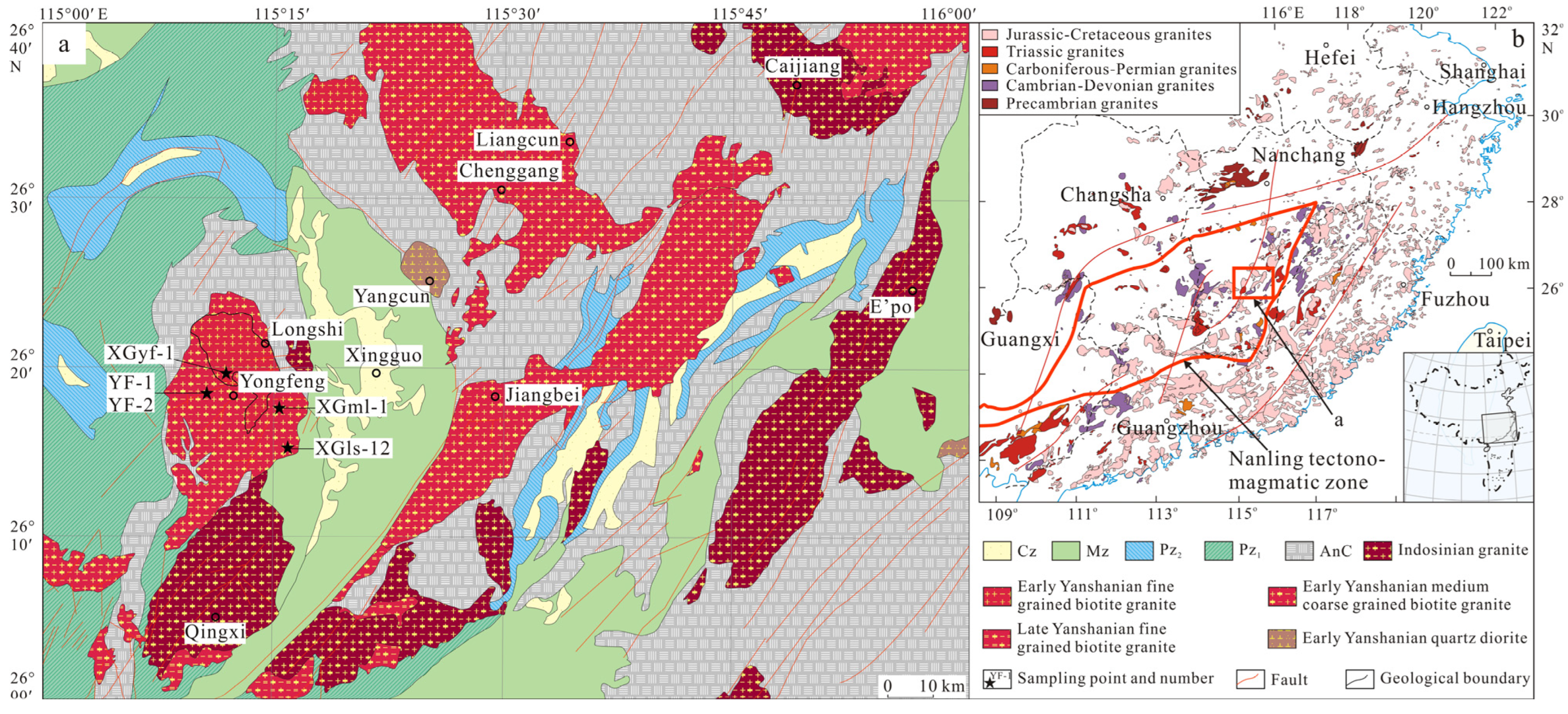
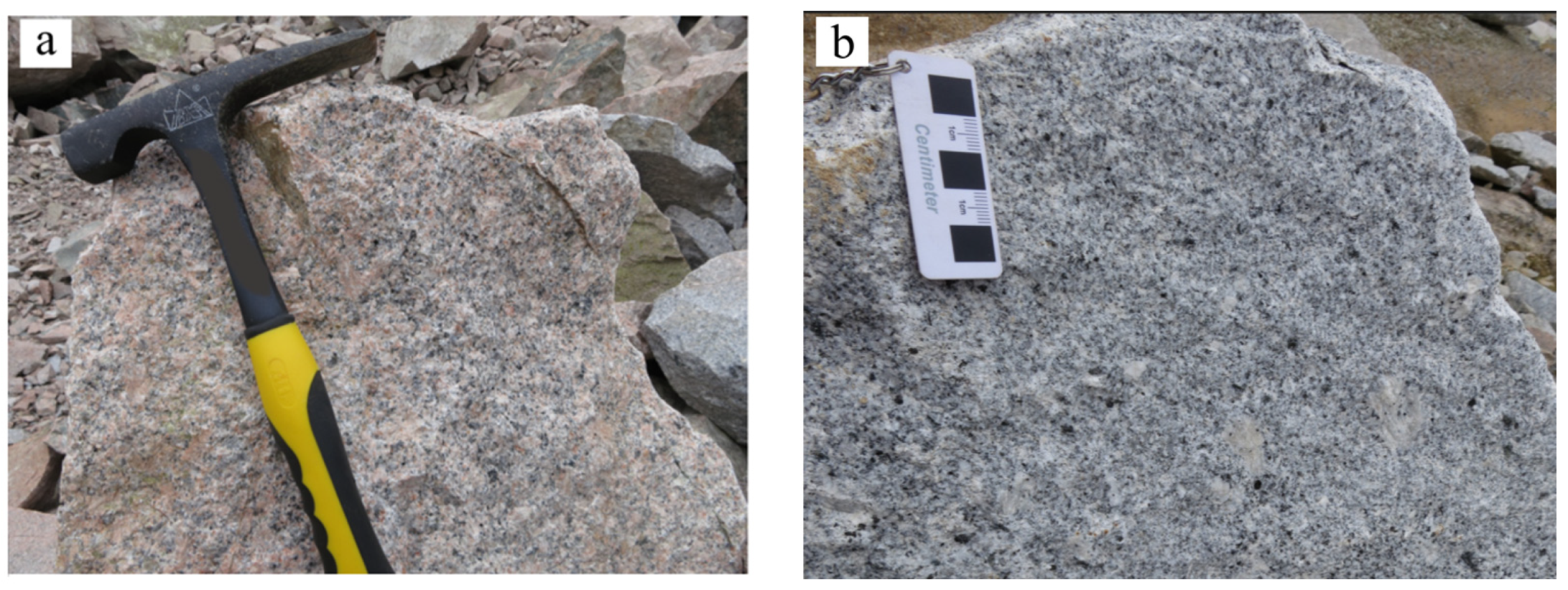
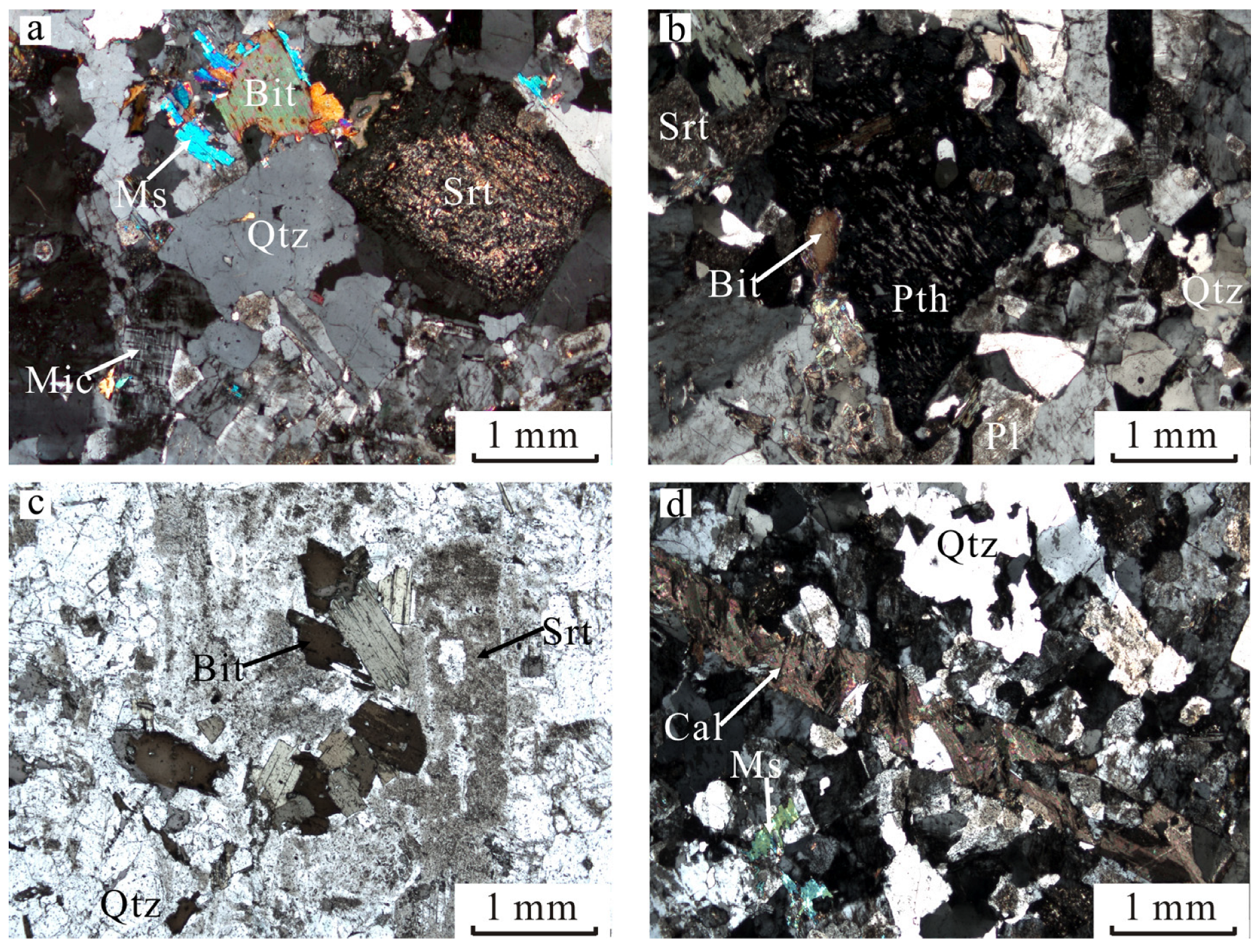
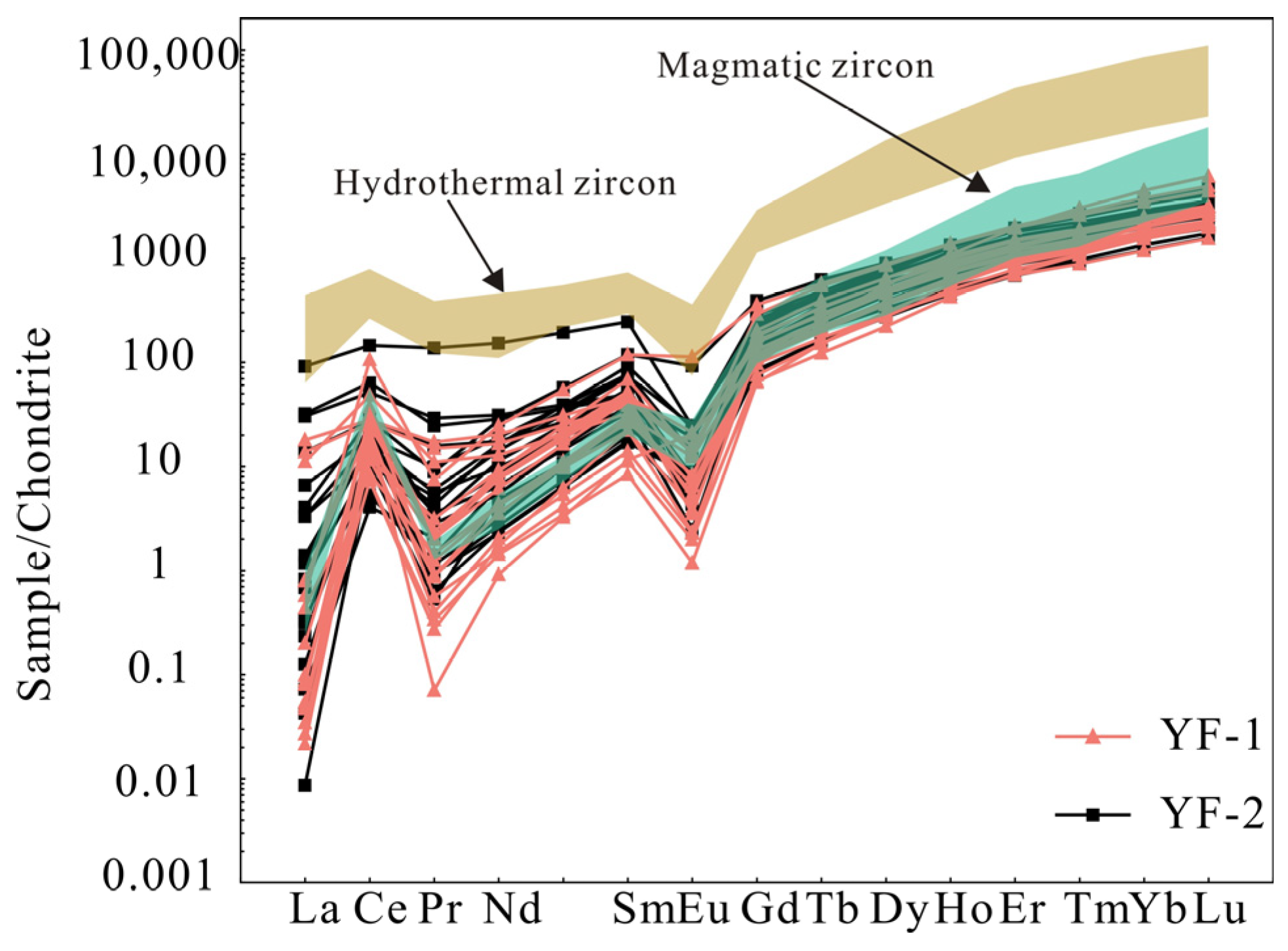
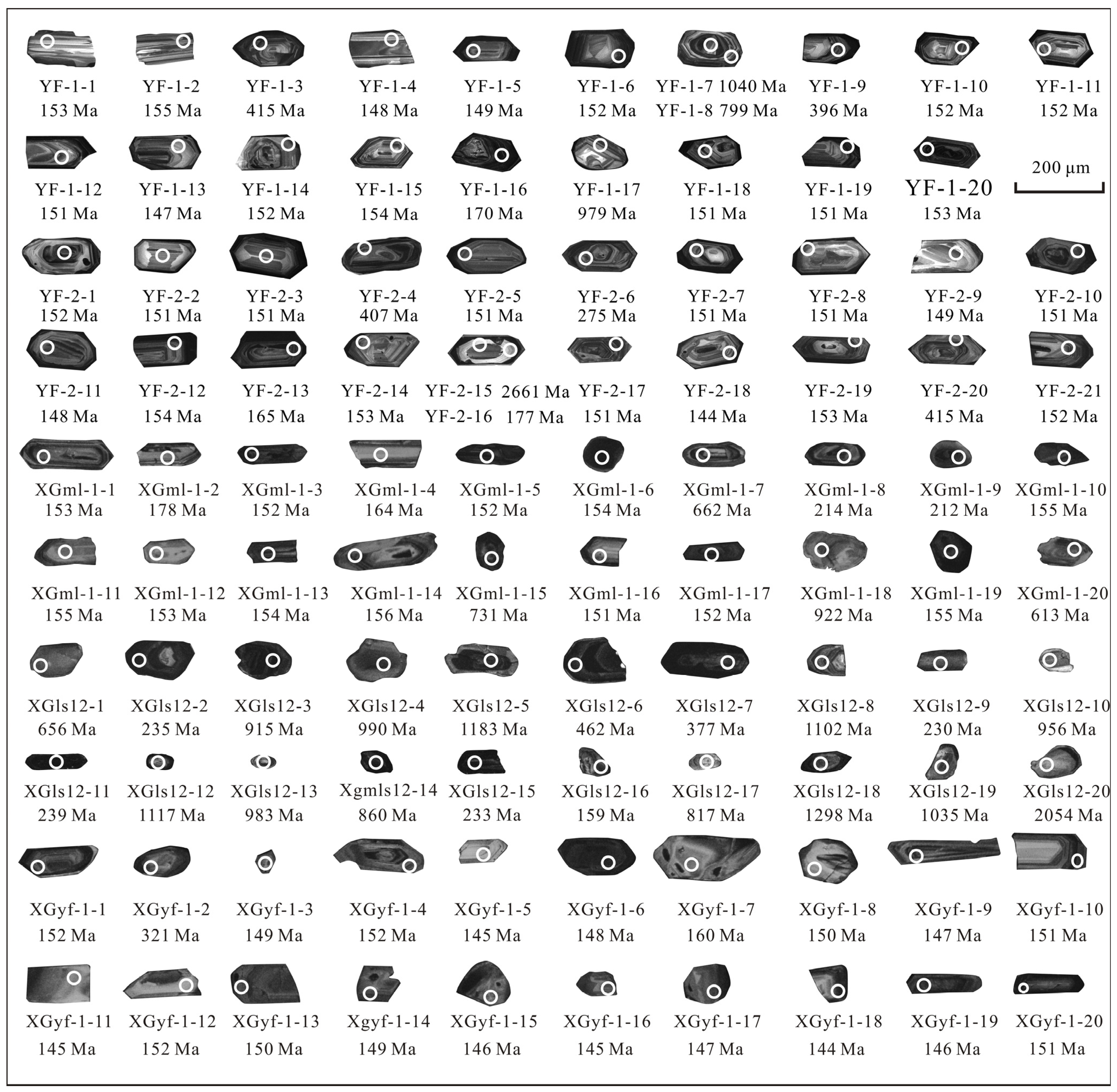
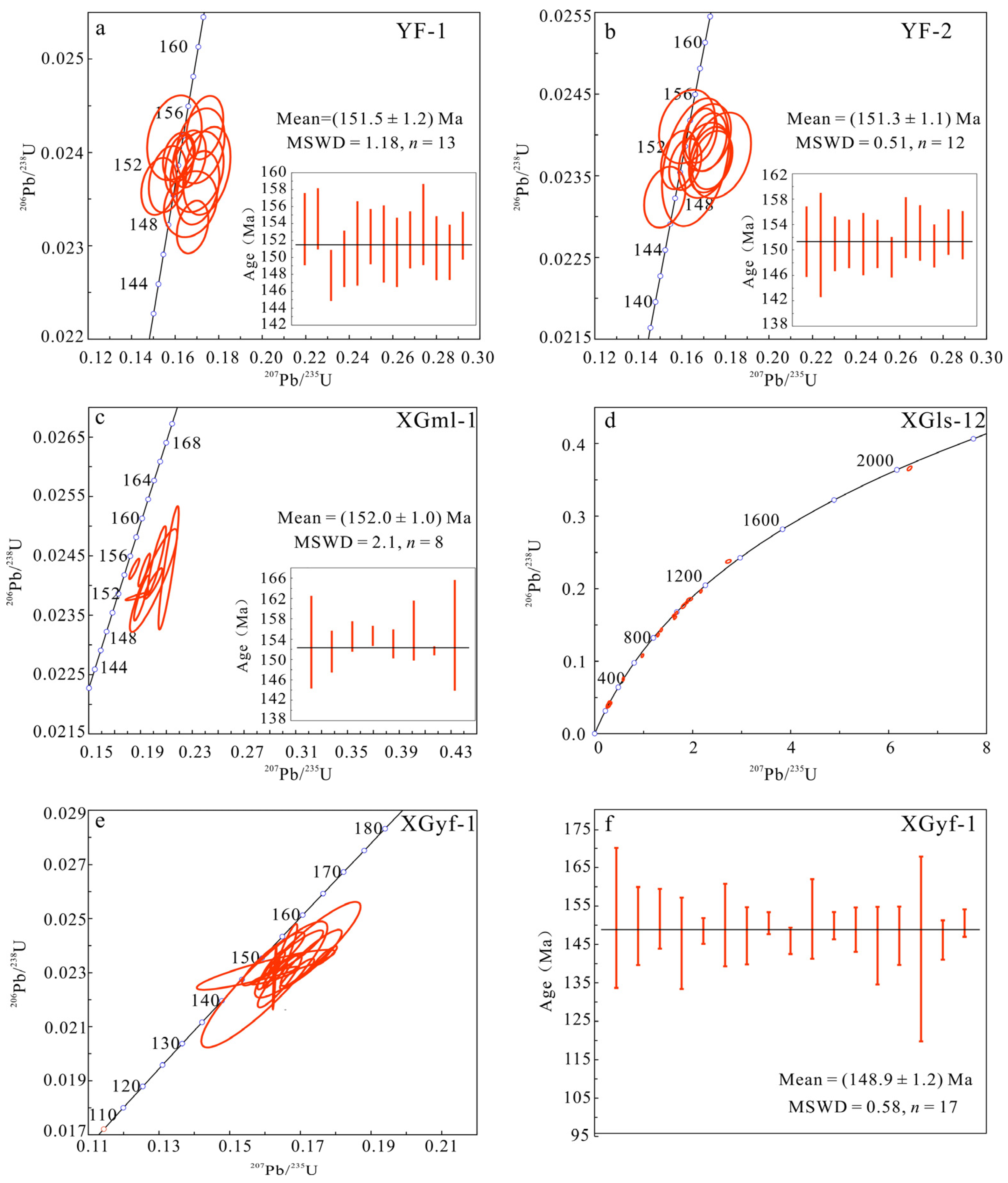

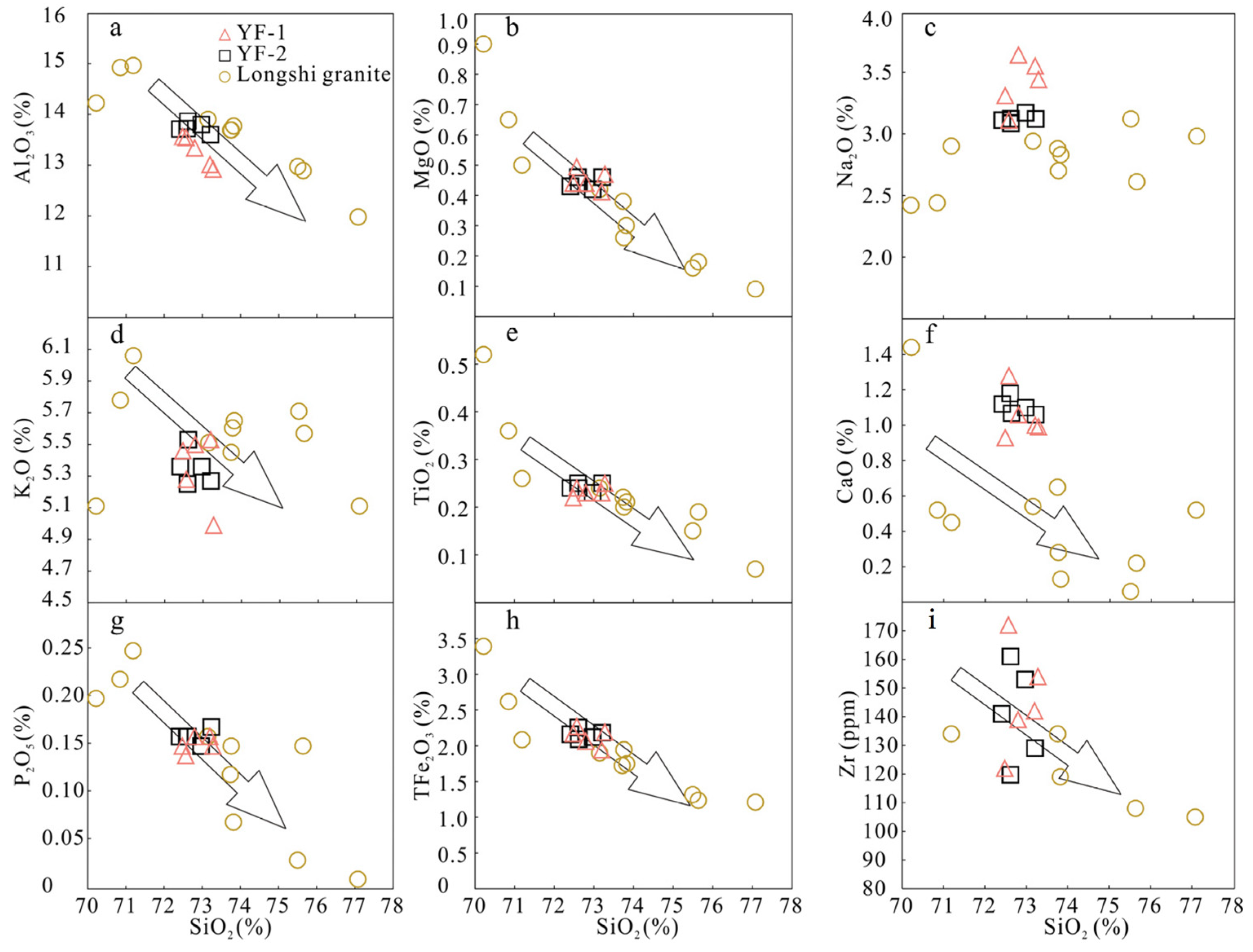

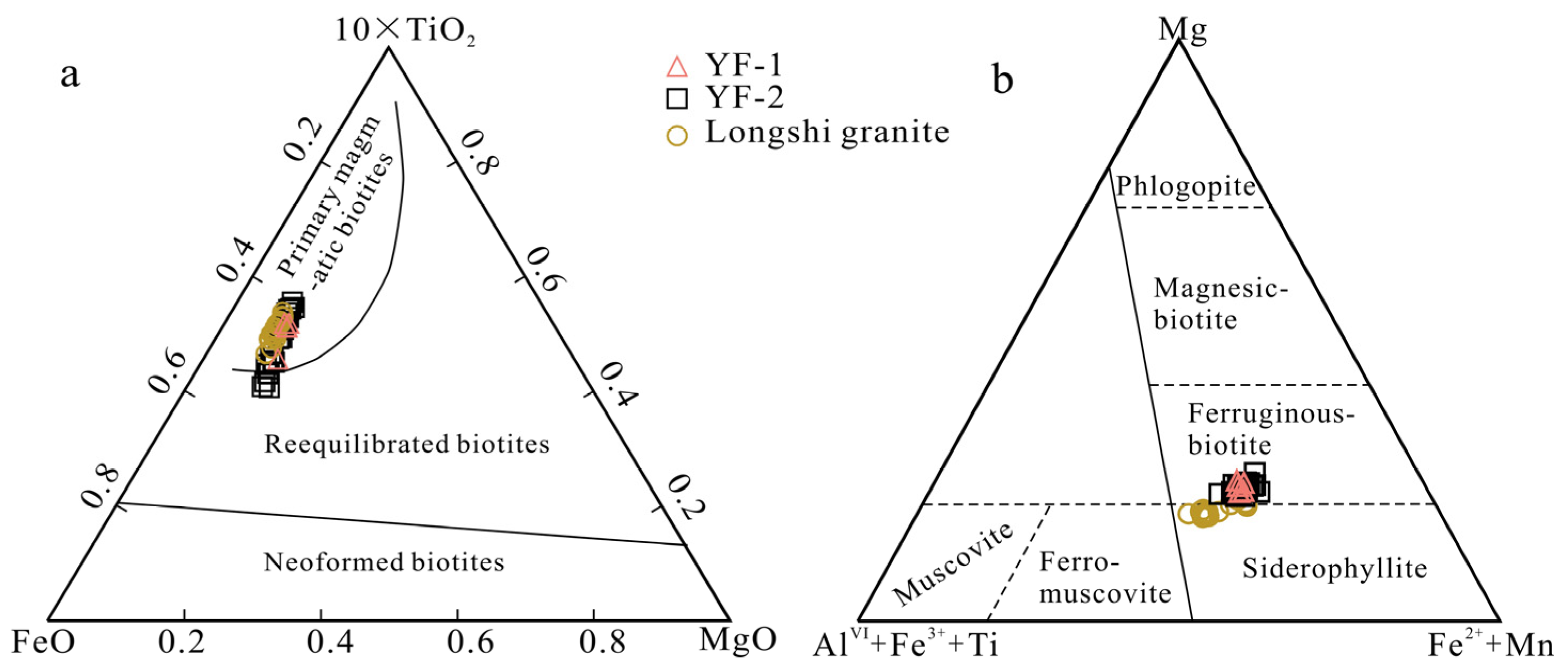
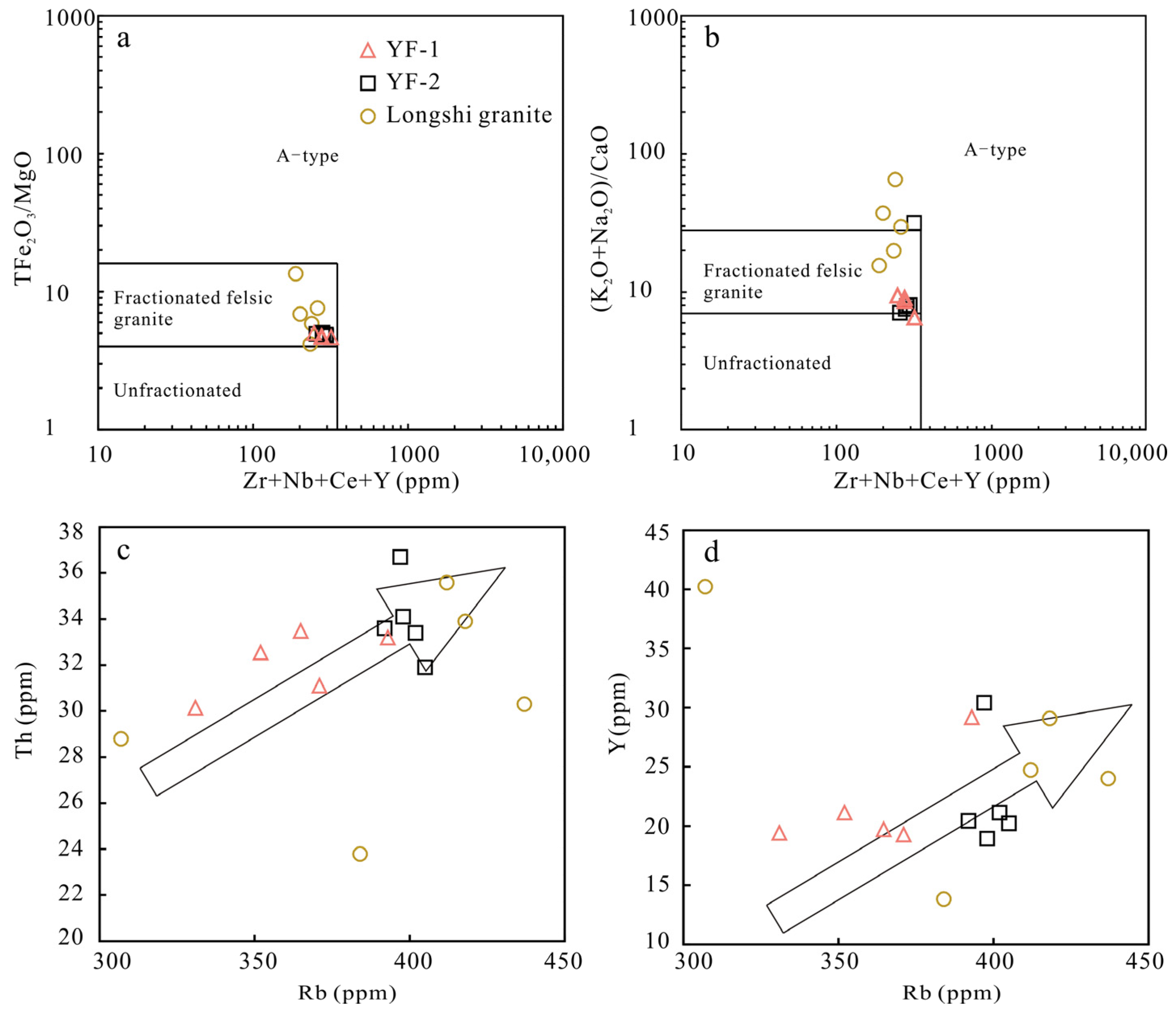
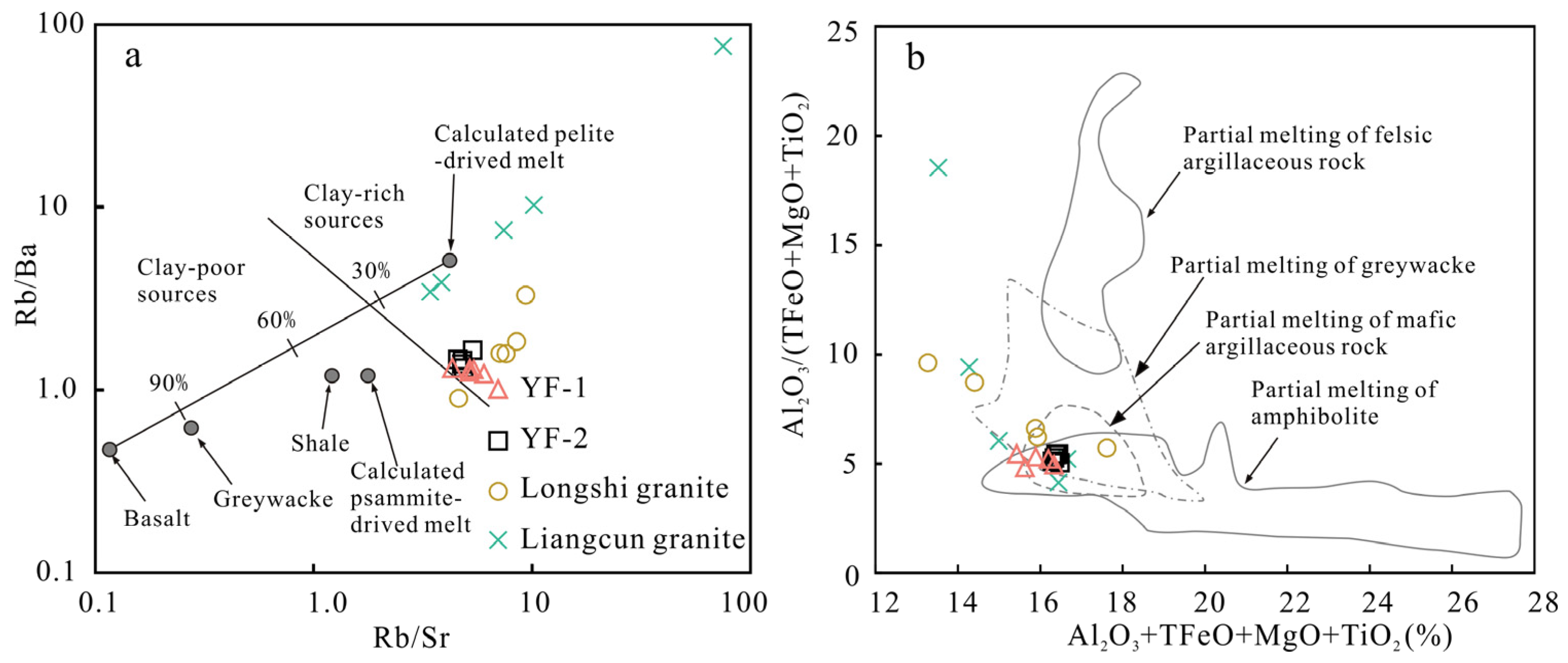
Disclaimer/Publisher’s Note: The statements, opinions and data contained in all publications are solely those of the individual author(s) and contributor(s) and not of MDPI and/or the editor(s). MDPI and/or the editor(s) disclaim responsibility for any injury to people or property resulting from any ideas, methods, instructions or products referred to in the content. |
© 2023 by the authors. Licensee MDPI, Basel, Switzerland. This article is an open access article distributed under the terms and conditions of the Creative Commons Attribution (CC BY) license (https://creativecommons.org/licenses/by/4.0/).
Share and Cite
Zhao, Y.; Huang, F.; Wang, D.; Wei, N.; Zhao, C.; Liu, Z. U-Pb Geochronology, Geochemistry and Geological Significance of the Yongfeng Composite Granitic Pluton in Southern Jiangxi Province. Minerals 2023, 13, 1457. https://doi.org/10.3390/min13111457
Zhao Y, Huang F, Wang D, Wei N, Zhao C, Liu Z. U-Pb Geochronology, Geochemistry and Geological Significance of the Yongfeng Composite Granitic Pluton in Southern Jiangxi Province. Minerals. 2023; 13(11):1457. https://doi.org/10.3390/min13111457
Chicago/Turabian StyleZhao, Yunbiao, Fan Huang, Denghong Wang, Na Wei, Chenhui Zhao, and Ze Liu. 2023. "U-Pb Geochronology, Geochemistry and Geological Significance of the Yongfeng Composite Granitic Pluton in Southern Jiangxi Province" Minerals 13, no. 11: 1457. https://doi.org/10.3390/min13111457
APA StyleZhao, Y., Huang, F., Wang, D., Wei, N., Zhao, C., & Liu, Z. (2023). U-Pb Geochronology, Geochemistry and Geological Significance of the Yongfeng Composite Granitic Pluton in Southern Jiangxi Province. Minerals, 13(11), 1457. https://doi.org/10.3390/min13111457





